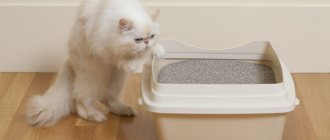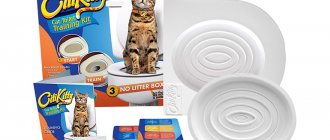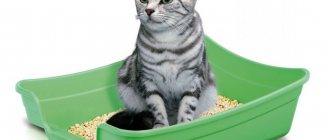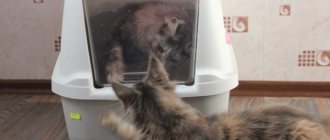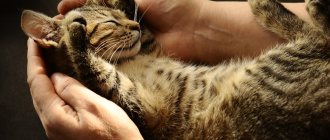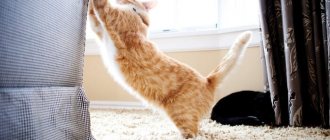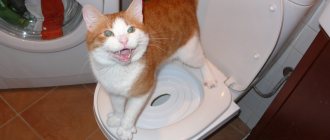10061Pavel
1
How to stop a kitten from pooping in the wrong place? How to accustom your furry pet to the cat litter box? These are the most pressing questions that interest everyone who is planning or has already adopted a cat as a pet. Representatives of the cat family are very clean animals, but if useful, correct behavioral skills are not instilled in a timely manner, they can cause a lot of problems. At the same time, walking on the dining table and sharpening claws on upholstered furniture may seem like innocent pranks compared to puddles on the carpet or in other secluded places and a specific smell. The following useful tips will help you if the kitten begins to shit in the wrong place.
Preparation
The appearance of a kitten in the house - such a decision should be made at a family council, since its presence should evoke positive emotions. If you are bothered by the noise caused by the kitten’s playfulness, its nightly “vigils,” and its fur constantly flying in the air, then you should wait to purchase a kitty.
Before the baby arrives in the house, it is necessary to make some preparations. First of all, this concerns the choice of tray. The store sells trays with different side heights. If you have already decided on the breed, you can guess the future parameters of your pet. The tray should be designed for an adult cat, since it is quite possible for a small kitten to overcome a side that is twelve centimeters high, but a grown cat will feel uncomfortable in a ditch that is not the right size.
The next step is where the tray will stand. The corner should be secluded, as the kitten does not like to show off its affairs. A toilet or bathroom is good for these purposes, provided there is enough space. The main thing is that the pipes do not rattle and the water does not make loud noise, which can scare away the baby.
It is important to find out from breeders or previous owners how their kitten went to the toilet. If you used a certain brand of filler, then purchase exactly that one for the first time, and then gradually replace it with the one you prefer. If the kitten went to the newspaper, then you will have to use this option, and then switch to a more convenient one.
And remember, the litter box should appear in the house with the kitten, and no inheritance from previous furry residents or neighbors. Cats have an excellent sense of smell, and no matter how hard you try to wash the used tray for the new owner, everything will be to no avail.
Selecting a location
The owner wants to immediately put the cat’s litter box in the “right” corner, so that it is not in plain sight. However, owner and pet preferences may differ.
Basic requirements for choosing a location:
- A secluded and quiet corner is needed. Loud noises frighten both small and adult cats.
- The animal should always have access to it.
When potty training an adult cat, place it in a secluded place. A kitten who lived with the breeder in the same room with its mother may get confused in a large apartment and forget where the toilet was assigned to it.
It is better to allocate a personal corner for the baby and place the tray not far from the sleeping place so that the little one has time to run. When the pet gets used to it, the container can be moved to the bathroom or any other room, but with constant access. This means either keeping the door open or making a small cat door in it.
If you bought a quality product, but your baby ignores it, it’s probably the place that he doesn’t like. An option is to buy several inexpensive pallets and place them around the house. Observe which one your pet prefers. Remove the rest, and gradually move the one you like to the desired part of the apartment.
How to accustom a kitten to a litter tray
Here are some recommendations that you can follow to quickly train your kitten to use the litter box.
- The first thing to do is to limit the space in which your new family member eats, sleeps, and frolics. This measure is necessary to ensure that the kitten is always visible for the first few days. Try to locate this area closer to the room where you spend most of the time. In this case, it will be possible to constantly keep the kitten in sight and quickly take action if he does not want to use the litter box.
- It is necessary immediately, as soon as the kitten gets into the new room, to show him the tray and the place where he stands. From time to time, place your furry family member in a litter tray so that he can remember the smell.
- Strictly control food intake and sleep time so that you can immediately take him to the potty.
- When placing the kitten in the tray, see if it drips clay or sawdust. If not, then grab him by the paws and make raking movements with them. Such attempts must be repeated several times.
- The kitten must be supervised at all times. If you notice that he sits down past the tray, carefully without sudden movements or haste, move the baby into the tray. He will have no choice but to use your service. When finished, be sure to pet him and praise him.
- If an “accident” does occur, blot the puddle with an odorless napkin and place it in the filler. The smell of urine in cats is very persistent and will attract his attention next time.
- For exemplary behavior, be sure to praise the kitten by talking affectionately to it. And if the kitten avoids the litter box over and over again, be patient, don’t even think about yelling at him, much less hitting him hard, and be persistent in the process of training the kitten to use the litter box.
Tray selection
Looking at a one-month-old kitten, many people think that it needs the smallest tray.
You can learn how to determine the age of a kitten from the article
But it is not so. Taking care of the baby in this case is quite understandable, but it should be remembered that the animal will grow quite quickly.
The weeks will fly by unnoticed: today the kitten is a month old, and after, it would seem, a couple of days he is already 1.5 months old, a little more and he has reached two months of age.
Before you even blink your eye, the furry baby will turn into a respectable cat that no longer fits in its toilet.
And if you are the happy owner of one of the large breeds , such as Maine Coon , Ragdoll or Savannah , then in this case the smallest toilet is out of the question.
If you rely on the advice of veterinarians, then you should immediately purchase a tray with sides of about 8-10 cm: the pet can easily overcome them, the main thing is that he wants to do it.
But the height should not be too high.
In any case, as the animal grows, you will have to change its litter box to a larger one once or twice.
And in order to accustom a kitten to the litter box fairly quickly, it is necessary that it meets the following requirements:
- complete absence of foreign odors;
- the material from which the toilet is made should not oxidize upon contact with feces;
- The tray should not rattle when the kitten tries to cover its “footprints”, otherwise it will scare it.
The baby should feel comfortable and safe
Thus, it turns out that the most suitable option is a plastic tray.
It may come complete with a grille or be without it.
What to buy is up to you, but here you need to take into account that a toilet with a grate is more convenient to use.
This way, liquid feces will pass through it, and your pet’s paws and fur will remain clean.
This aspect is especially relevant when your apartment contains a representative of one of the long-haired breeds, for example, a Persian , Siberian , or Norwegian cat .
How to accustom a kitten to a litter box without litter
The purchase of filler entails significant expenses for the family budget. If you can't afford it, you can train your kitten to use a litter box without litter. Show the tray to your baby and rummage along the bottom with your paws. If, however, a puddle appears in the wrong place, blot it with a clean, odorless napkin and place it in a tray to transfer the kitten’s amber into it.
After some attempts, the kitten will learn to go to an empty tray. But it is important that after each use of the toilet, be sure to wash the cuvette with clean water, without bleach or any detergents. Otherwise, a urinary stone will quickly form at the bottom.
Often cat owners use torn newspaper as litter for the tray. Kittens like this method. But again, this “filler” must be removed after each trip to the toilet. Otherwise, the pet will ignore the wet tray and do its business elsewhere.
The version of the tray without filler is suitable only for owners who are constantly at home and can clean up after the kitten in a timely manner. If the kitten is alone at home all day or most of the day, then the option of loose litter for the tray will be the only acceptable one. If filled with enough filler, your pet can go several times without any problems. Just when you come home from work, do something nice for him - put the tray in order.
How to stop a kitten from pooping in inappropriate places
If the kitten stubbornly poops in the wrong litter box, try changing the litter. Perhaps the chosen brand does not meet your pet's needs. Granules that are too large can end up in the paw pads. The specific smell scares the kitten away from the litter box or provokes allergies, especially in high-breed cats. If your kitten shits, choose a litter based on your pet's personality.
If a cat craps, felinologists recommend changing the cat litter gradually. Cats become accustomed to a particular smell. An unknown aroma can scare the fluffy one away from the potty, so mix new litter with a small amount of old. If your cat poops, choose the best litter for the litter box that your pet will like.
If your kitten poops in the wrong place, move the cat potty to a quieter area. Cats are quite shy and prefer to relieve themselves in secluded corners where no one bothers them. Let us remind you that adult cats and kittens will not shit in inappropriate places in a house or apartment without special reasons.
If the cat shits everywhere
But sometimes it happens, no matter how much effort you make to accustom your cat to the litter box, from time to time she craps wherever she pleases. It often seems that the cat does this because of its grievances. But this is not true. In fact, this “disgrace” may have several reasons.
In this state of affairs, experts advise doing a full examination of the cat’s body. After all, persistently ignoring the filler can signal the initial stage of serious diseases. These could be kidney or bladder problems, constipation, or inflammation of the thyroid gland. If the doctor did not reveal any pathology, then the cause of hooliganism lies only in your uncleanliness. To make a cat feel comfortable, a minimum of effort is required, namely:
- Throw away a lump of wet litter every day;
- Renew it in small doses;
- Once a week, be sure to remove all the litter and then thoroughly wash the tray using urinary stone removers and disinfectants. Wipe the tray dry.
If the activities described above are carried out by you with enviable regularity, you need to look for another reason for refusing the tray. This may be the quality of the filler itself. It is good to use the filler that was used by the breeder. It is possible to use the same absorbent composition. The cat, out of established habit, will definitely sit on such soil.
When changing the filler, this must be done with caution. First add it a little at a time so that the cat can get used to it, and then after a while replace it completely.
It is necessary to talk separately about the filler. It comes in various qualities, sizes and purposes. Fillers are divided into:
- Moisture-absorbing;
- Clumping;
- Selicohelium.
The first and second are made from a certain clay or wood shavings, pressed into certain granules. The latter are made from specially processed polysilicon clay. But due to the complex form of manufacture, this filler is much more expensive than others. Its high cost is compensated by its high efficiency, so one serving can be used for up to four weeks.
If the cat does not go to the litter box, but poops anywhere, then the litter is not suitable for her. And you will have to start selecting it.
A cat shits in a flower pot: what to do?
The cat can choose a flower pot as a toilet.
Cats are famous for the fact that they can rake soil out of flower pots or, even worse, shit in them. Here are the tricks of “cat people” that help wean fluffies from such bad habits:
- isolate pots of flowers (especially poisonous ones) from the cat
- put dry citrus skins in flower pots, cats don’t like their smell
- cover the soil in pots with foil, plastic wrap, thin plastic trays, etc.
What to do if your cat shits on the floor
The cat has an excellent litter box with excellent filling, but he still prefers the floor, then you should think about whether the family pet is looking for a girlfriend? This will be shown by his behavior - on the one hand, an excited state, accompanied by wandering around the apartment with an unnatural meow, and on the other hand, the cat shows increased affection, constantly rubbing, “hugging.” Puddles will appear in different places and have a very rich smell. If you are careful, then during such a period you can notice how the cat lifts its tail from time to time and shakes it.
Of course, the best way out of the situation is to provide the cat with a sexual partner. But if this is not possible, then you will have to limit yourself to special drugs that inhibit the cat’s sexual activity.
Methods of litter box training
For some owners, the training process happens quickly, for some the pet is stubborn for a very long time, and for others, they don’t have to do anything at all. The kitten goes where it needs to go on its own, as if it always went there. To maintain your nerves, health and learn how to toilet train your pet, follow our instructions.
The cat shits on the carpet and in the corners
When training a kitten to use the litter box, you may accidentally hear an unpleasant odor coming from the carpet in the living room or from the most distant corner.
The reason for this behavior may be health problems. If a cat has chosen a fluffy carpet, it means that something hurts him, and it is painful for him to go to the toilet made of hard litter. It could be urolithiasis. To find out, take the test to a veterinarian to confirm or refute your concerns.
A cat may choose corners or places under the bed if it is in a state of fear, received from evil and cruel owners or from strong external noise, for example, repairs. Change your attitude towards your furry family member or complete repairs as soon as possible, and then the animal’s condition will improve, and he will easily get used to the tray.
There are often cases when a cat, being small, goes to the toilet perfectly. And when they reach sexual maturity, problems arise, and all methods and means turn out to be useless, there is only one way out - castration in cats or sterilization in cats. And then peace will be established in the house.
The cat pees past the potty: what to do?
It happens that a cat runs to the tray, but sits on the edge or raises the back of its body high, so it relieves itself past, on the floor near the potty. The reasons for this behavior may be the following:
- the cat has health problems (for example, arthritis, it hurts to sit down)
- the filler in the tray is dirty, it has not been changed for a long time
- the tray is too small for the animal
The cat may walk past the litter box if it is too small.
You can deal with this situation:
- Have the animal examined by a veterinarian.
- Maintain tray hygiene.
- Buy a more spacious tray, with high sides, or a house tray.
- Place an absorbent disposable diaper under the tray.
How to get rid of unpleasant odor
In the process of training a kitten to use the litter box, it is distressing when the baby passes by. But the smell of urine from a prepubescent kitten is not very irritating to the sense of smell and can be easily cleaned out. But if an adult cat confuses the tray with a sofa, carpet or the owner’s clothes and commits an obscene act, then it will be very difficult to completely get rid of the strong odor.
Here are some tips suggested by our readers:
- The easiest way is to blot the wet spot on the upholstery of the sofa, carpet, bed with an old cloth or paper towel, toilet paper or newspaper. At the same time, make only pressing movements and under no circumstances rub. This will increase the area emitting the smell significantly.
- A solution of vinegar and water in a ratio of one to two removes a specific odor well. It is necessary to apply this solution with a spray bottle several times to the stained area, each time allowing it to dry. The effect will be enhanced by using a washing vacuum cleaner for cleaning.
- Regular baking soda works well to remove urine odor. Sprinkle the washed area with baking soda, and apply a mixture of three percent hydrogen peroxide and dish detergent on top. Thoroughly distribute the soap solution over the baking soda powder, let dry and clean with a vacuum cleaner.
- They perform excellent disinfection, and therefore remove odor, potassium permanganate or iodine. To do this, prepare a weak solution of potassium permanganate or an iodine solution of ten drops per liter of water. But it is worth remembering that each of these products can stain the surface being treated. Therefore, before use, be sure to test in an inconspicuous area.
- You can use fresh lemon juice. The citrus scent will not only remove urine odor, but will also prevent relapse, since the cat does not like this smell.
- A universal remedy in the fight against the consequences of cat uncleanliness is laundry soap.
Tips from our readers for getting rid of urine odor
You can leave your feedback on how to train a kitten to use the litter box and how to get rid of the smell of urine: Galina, 38 years old. Novosibirsk
“In our house there lives everyone’s favorite cat, Musya. This is a very smart cat, but willful. Very rarely, without any reason, it can make a puddle past the tray. I tried many folk recipes. Some worked better, others poorly. Therefore, I decided to conduct an experiment and combined two recipes into one, namely, I combined vinegar, vodka and water in equal parts in one solution. I treated the surface with this product, left it to dry and then washed it thoroughly, first with soapy water and dish soap, and then with clean water. The smell was completely removed."
Valeria, 42 years old, Samara.
“If a cat gives unpleasant surprises on the carpet, this is what I do. I blot the moisture as thoroughly as possible and rinse with water. But in this case, I try to moisten it more strongly and cover the area with a thick layer of regular washing powder. I leave it overnight, and in the morning I just rinse with clean water.”
What not to do
Under no circumstances should you punish your pet. If you start poking your animal’s nose into his feces, he will not understand that he is being scolded for going to the toilet in the wrong place; he will simply regard this as a punishment for a completed physiological act. In the future, the cat will hide from you in more secluded places in order to carry out its “dirty deeds”.
You should not forcefully hold your pet in the tray while waiting for him to go to the toilet. The animal will simply get scared and will avoid the tray.
The cat will definitely understand what they want from him - you just need to be affectionate towards your pet. It is not an easy task to accustom an outdoor cat to a litter box, and the result will depend on how you behave. The main key to success is patience; after a certain amount of time, the cat will definitely figure out what to do, and you will find happiness and peace.
